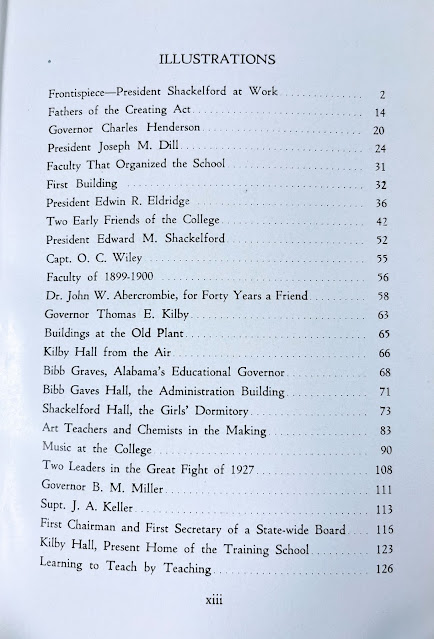I began working at Auburn University's Draughon Library in 1973; in 2015, I retired as librarian for the UAB Department of Anesthesiology. In between those places I worked at Tuscaloosa Public Library. Thus, if my math is correct, I worked for 42 years in libraries in Alabama, academic, public, and medical. So I thought for my 801st blog post I'd discuss this little publication, the Proceedings of the First Meeting of the Alabama Library Association, an account of the gathering held in Montgomery on November 14, 1904.
I've written some other pieces on library history in the state. The topics include Carnegie libraries, the state's first library, libraries in Alabama in 1851, unusual libraries in Birmingham, bookmobiles and traveling libraries, and medical libraries. I'm also working on "Alabama Libraries Before 1920: A Chronology in Progress" found here.
Papers presented at the meeting are included in this book, but as can be seen in the contents below most address general library topics with little or no Alabama content. The one exception is Thomas Owen's "Public and School Libraries in Alabama" which is an attempt to list those libraries in the state operating at that time.
Perhaps the most useful material here is the listing of officers and charter members. This provides a snapshot of the library community in Alabama in 1904, both actual librarians and the friends of libraries. One of the latter was Russell Cunningham, M.D., then Lieutenant Governor of the state. Others included John Abercrombie, President of the University of Alabama, and novelist Frances Nimmo Greene, who at that time was principal of Capitol Hill School in Montgomery. Thomas Owen was founder and director of the state archives, the first such organization in the U.S. His wife is listed as Mrs. Thomas Owen. She was Marie Bankhead Owen, a member of the prominent political Bankhead family and aunt to actress Tallulah. She would become director of the archives for 35 years after her husband died in 1920.
A preliminary announcement with a tentative program was issued prior to this meeting. That publication also contained the announcement of a second meeting to be held in Mobile in 1905 and included a tentative program. That program indicates more papers with Alabama material would be presented.
In his "Prefatory Note" Owen acknowledges "the work of the meeting was not in any way notable", due to the fact that library development in the state was only beginning. He felt the papers would especially aid "the village librarian, the struggling teacher, and the poorly equipped library assistant" rather than the state's professionals, which were few at the time. Presumably he would be pleased to see the development of both libraries and librarians in Alabama over the past 100 years.
In 1962 Jean Le Furgey Hoffman completed a dissertation at Florida State University, "The Alabama Library Association, 1904-1939: A History of Its Organization, Growth and Contribution to Library Development." That dissertation can be downloaded as a PDF here. The Alabama Library Association's web site provides information on current activities.
I've written about a 1922 silent film based on one of Greene's novels here.
The meeting was held at the new Carnegie Library in Montgomery at the corner of Adams and Perry Street.































































